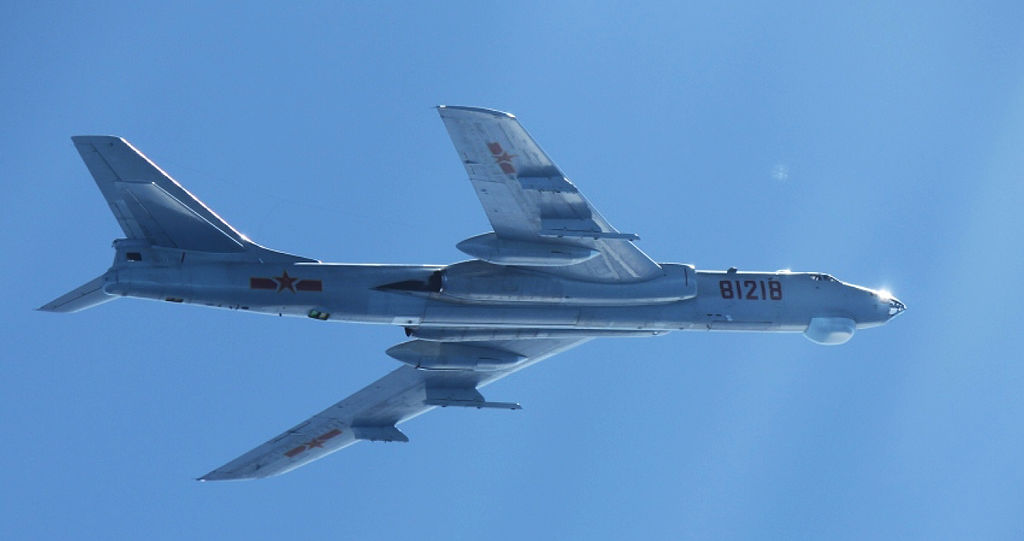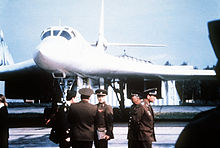Wikipedia Blackjack Bomber
| Tu-28/Tu-128 | |
|---|---|
| Tu-128 at the Central Air Force Museum at Monino, Russia | |
| Role | Interceptor |
| Manufacturer | Voronezh Aircraft Production Association |
| Design group | Tupolev |
| First flight | 18 March 1961 |
| Introduction | 1964[1] (or 1966[2]) |
| Retired | 1990 |
| Status | Retired |
| Primary user | Soviet Air Defence Forces |
| Number built | 198[1] (including 10 trainers) |
| Developed from | Tupolev Tu-98 bomber prototype |
- Tu 160 Blackjack Bomber
- Wikipedia Blackjack Bomber Fighter
- Wikipedia Blackjack Bomber Helmet
- Wikipedia Blackjack Bomber Jacket
The TU-160 Blackjack is the 16th largest aircraft and is a Soviet sweep wing supersonic strike bomber. It is the world's largest direct-combat aircraft, largest supersonic capable aircraft and largest swept wing aircraft, EVER! Many records go to the Blackjack although it sees little combat service. The TU-160s 4 engines are some of the most powerful ever built for atmospheric travel and the. A bomber is a combat aircraft designed to attack ground and naval targets by dropping air-to-ground weaponry (such as bombs), launching torpedoes, or deploying air-launched cruise missiles. The first use of bombs dropped from an aircraft occurred in the Italo-Turkish War, with the first major deploy.
The Tupolev Tu-28 (NATO reporting nameFiddler) was a long-range interceptor aircraft introduced by the Soviet Union in the 1960s. The official designation was Tu-128,[2] but this designation was less commonly used in the West. It was the largest and heaviest fighter[nb 1] ever in service.[2][3]
Su-34 (Su-32) Bomber Flanker Su-27M (Su-35) Super Flanker Su-35 4 Generation Flanker Su-37 Terminator Tu-22 Blinder Tu-22M Backfire Tu-160 Blackjack: Aero L-159 ALCA AMX International AMX Dassault/Dornier Alpha Jet Dassault Mirage III Dassault Mirage F1 Dassault Mirage 2000 Dassault Rafale Eurofighter Typhoon Panavia Tornado Saab J 35 Draken. The Tupolev Tu-160 ( NATO codename: 'Blackjack' ) is a supersonic, variable sweep wing, strategical heavy bomber aircraft. The Tu-160 is the largest and heaviest military aircraft ( beside Transports ) currently in existence. The Tupolev Tu-160 entered service in 1987 and 16 aircraft are currently in service with the Russian Air Force. Development The Soviet Union started in 1967 a competition.
Background[edit]
In the 1950s, the Soviet Union sought means to defend against nuclear-armed American bombers possibly penetrating its borders (especially its long and vulnerable northern border), flying from northern Soviet bases like Talagi Airport and Savatiya (air base).[4][5][6] Contemporary interceptors, even the Yakovlev Yak-28P, were able to cover only a radius of a few hundred kilometers;[1][7][8] the newly developed surface-to-air missiles had even shorter range[1](the standard Soviet SAM S-75 Dvina's range is 45 km (28 miles)). Considering both, the sheer numbers required to defend a 5,000 km air front[nb 2] were economically impossible to maintain. This left the Soviet Union able to provide a modern air defense only for selected valuable areas.[8] The PVO decided to cover the entire territory, but with a looser defence. In 1955 it placed a requirement for a large area-defense interceptor, that would achieve it with sparse[nb 3] airbases. The PVO requirement called for a supersonic aircraft with enormous fuel tanks for both a good patrol time and long range, a capable radar, and the most powerful air-to-air missiles possible. The first attempt, although unsuccessful, was a 30-tonne Lavochkin La-250 prototype,[8] the last of the Lavochkin design bureau's aircraft.

Design and development[edit]
Iosif Nezval[2][8] of Tupolev Design Bureau led development of the new interceptor aircraft. The work began in 1958, based on an existing single prototype of the unsuccessful Tu-98 supersonic bomber. The military designation of the interceptor was at first Tu-28, but it was changed in 1963 to Tu-128, identical to the designation used by the OKB.[1][2][8]
The Tu-128 had a broad, low/mid-mounted swept wing carrying the main landing gear in wing-mounted pods, and slab tailplanes. Two Lyulka AL-7F-2 turbojet engines[1][2] were mounted in the fuselage. The two-man crew of pilot and navigator were seated in tandem.
The Tu-128, with its maximum weight of 43 tonnes, was the heaviest fighter to enter service.[nb 1][2] It was a bomber-interceptor with high wing loading, unsophisticated but reliable avionics and poor visibility. It was not an agile aircraft.[2] It was intended to combat only NATO bombers like the B-52,[2][8] not engage in dogfights with smaller aircraft.
The interceptor made its initial public appearance in the 1961 Tushino air parade. Western experts, unaware that the bulge on the belly carried testing instruments, mistook it for a large ventral radar for a mixed interceptor/AWACS role.[3] The production version lacked the bulge and had a large nose radome housing a radar, known as RP-S[nb 4]Smerch, having a detection range of about 50 km (31 mi[2]) and a lock-on range of about 40 km (25 mi).[1]
Armament of the Tu-128 was four Bisnovat R-4air-to-air missiles (known as K-80 during development;[1]NATO reporting name AA-5 'Ash'). Usually two of them were R-4Rs with semi-active radar homing and two were R-4T infrared-homing missiles, with the former on the outer pylons and the latter on the inner underwing pylons. There was no internal weapons bay.
Production of the Tu-128 ended in 1970 with a total of 198 aircraft having been built.[1][9]
Development of various projects designated Tu-28A, Tu-28-80, Tu-28-100, Tu-138, and Tu-148 were proposed by the Tupolev Design Bureau but all were abandoned.[1]
Operational history[edit]
The Tu-128's only publicly reported combat operation was the destruction of NATO reconnaissance balloons. The aircraft remained in service until 1990.[1][2] Through the 1980s, units armed with the Tu-128 converted to the Mikoyan MiG-31,[1][3] which features much more advanced sensors and weapons.[10]
Variants[edit]

- Prototype of Tu-28 ('Fiddler-A')
- Development test aircraft, one built. OKB designation was 128.[1][2][3] In the West, Fiddler-A was used for all the aircraft with twin ventral fins[2] — these included a prototype and a few of initial production (perhaps two[1] planes).
- Tu-128 (also known as Tu-28; 'Fiddler-B')
- Main version, first deployed operationally in 1964[1] (or 1966[2][8] – sources differ). The military designation was at first Tu-28,[2][8] but the existing aircraft were renamed in 1963.[1][11] The entire weapon complex (aircraft, radar, missiles) was designated Tu-128S-4.[1][2] In the Western sources, but not in Soviet, often the more precise designation of this version[3][7][9] is mentioned as either Tu-28P or Tu-128P.
- Tu-128UT (also known as Tu-28UT)
- Training version with an additional cockpit forward of the normal one, in place of a radar. ten built and four converted from standard interceptors.[1][11]
- Tu-128M
- A 1979 modernization of almost all[1] existing aircraft for better interception at low altitude. Development originated in 1970.[2] Engines and airframe were not altered.[1] The full designation of the entire weapons complex was Tu-128S-4M.[1][2][11] It contained a new RP-SM Smerch-M radar, and new missile set: R-4RM plus R-4TM.[1][11]
Abandoned[edit]
- Tu-28A
- New development, abandoned.[1][11]
- Tu-28-80
- Development designation, abandoned.[1][11]
- Tu-28-100
- Development designation, abandoned.[1][11]
- Tu-138
- New development, abandoned.[1][11]
- Tu-148
- New development, variable geometry wings, abandoned.[1][11]
Operators[edit]
- Soviet Union
- Soviet Air Defence Forces (never exported)[11]
Specifications (Tu-128)[edit]
Data from Tupolev : the man and his aircraft[2]
General characteristics
- Crew: 2
- Length: 30.06 m (98 ft 7 in)
- Wingspan: 17.53 m (57 ft 6 in)
- Height: 7.15 m (23 ft 5 in)
- Wing area: 96.94 m2 (1,043.5 sq ft)
- Empty weight: 24,500 kg (54,013 lb)
- Gross weight: 40,000 kg (88,185 lb)
- Max takeoff weight: 43,000–43,700 kg (94,799–96,342 lb)
- Fuel capacity: 13,600 kg (29,983 lb) maximum (estimated)
- Powerplant: 2 × Lyulka AL-7F-2 afterburning turbojet engines, 72.8 kN (16,400 lbf) thrust each dry, 99.1 kN (22,300 lbf) with afterburner
Performance
- Maximum speed: 1,665 km/h (1,035 mph, 899 kn) / M1.5 armed
- 1,929 km/h (1,199 mph; 1,042 kn) un-armed
- Range: 1,560 km (970 mi, 840 nmi)
- Endurance: >3 hours
- Service ceiling: 15,600 m (51,200 ft)
- Absolute ceiling: 20,000 m (65,617 ft)
- g limits:+2.5
Armament

- Hardpoints: 4
- Missiles: 4 × Bisnovat R-4air-to-air missiles (usually 2 × radar-guided R-4R and 2 × infrared-homing R-4T); other armament or tanks not used

See also[edit]
| Wikimedia Commons has media related to Tupolev Tu-128. |
- North American A-5 Vigilante[12]
Tu 160 Blackjack Bomber
Related development
Aircraft of comparable role, configuration, and era

Related lists
Notes[edit]
- ^ abTu-128 was the largest fighter assuming that the definition of 'fighter' includes an interceptor aircraft. Tu-128 was not intended for fighter-to-fighter combat (i.e. air superiority battle). For an even heavier interceptor design, which did not enter service, see Lockheed YF-12.
- ^The geographical distance between Murmansk and Anadyr is 4,911 km.
- ^For example, in 1972, a mere six air bases provided the sole interceptor cover for almost a half of the Soviet Union's interior. These bases employed most of the Tu-128 force.[2]:140[7]:259–262
- ^Some sources provide the radar's designation as RP-5 instead of RP-S, possibly a mistake.
Wikipedia Blackjack Bomber Fighter
References[edit]
Wikipedia Blackjack Bomber Helmet
- ^ abcdefghijklmnopqrstuvwxyzaa'Tu-128' (in Russian). Airwar.ru. Retrieved 3 March 2011.
- ^ abcdefghijklmnopqrstKandalov, Paul Duffy ; Andrei (1996). Tupolev : the man and his aircraft. Warrendale, PA: SAE Internat. pp. 137–139. ISBN978-1-56091-899-8. Retrieved 3 March 2011.
- ^ abcdeSpick, Mike (5 August 2002). The Illustrated Directory of Fighters. ISBN978-0-7603-1343-5. Retrieved 3 March 2011.
- ^https://www.aerosociety.com/media/3581/aerospace_mar2016.pdf
- ^Mladenov, Alexander (20 April 2017). 'Soviet Cold War Fighters'. Fonthill Media. Retrieved 29 January 2019 – via Google Books.
- ^'AviationsMilitaires.net — Kotlas-Savatiya (Russie)'. www.aviationsmilitaires.net. Retrieved 26 January 2019.
- ^ abcLeonard, Barry (January 2011). History of Strategic and Ballistic Missile Defense: Volume II: 1956–1972. pp. 109–114, 259–262. ISBN9781437921311.
- ^ abcdefgh'Tupolev Tu-28'. Russiafile.com. Retrieved 8 February 2010.
- ^ abAir warfare : an international encyclopedia. Santa Barabara (Calif.): ABC-Clio. 2002. ISBN978-1-57607-345-2.
- ^Roblin, Sebastien (1 April 2017). 'Russia's Super-Sized Tu-128 Fighter: The Supersonic B-52 Killer'. The National Interest. Retrieved 29 January 2019.
- ^ abcdefghij'WWW.AVIATION.RU'. Archived from the original on 5 June 2011. Retrieved 5 March 2011.
- ^Colon, Raul. 'Tupolev TU-128 Fiddler'. Retrieved 5 March 2011.